
PREMIER League, FEBRUARY 23 2025
Salah (14)
Szoboszlai (37)
Title-chasing Liverpool capitalised on Arsenal’s home loss to West Ham by taking maximum points at the home of reigning champions, Manchester City. Although City are not in this season’s title race, Liverpool’s victory at a club that has won six of the last seven Premier League titles gave this result added significance. Most importantly, it put the leaders 11 points clear with 11 games left, while second-placed Arsenal have 12 in which to attempt to overturn the deficit.
For this game City were without their leading goalscorer, Erling Haaland, but were still able to field their £59m January signing, Omar Marmoush. The Egyptian attacker had scored a hat-trick on his previous Premier League appearance for City. Here, though, it was his international teammate who shone brightest.
Mohamed Salah is having one of the best seasons of his illustrious career – this was the 11th Premier League game in which he has both scored and assisted. As a mark of how impressive he has been, not since Lionel Messi also scored and assisted in 11 games – for Barcelona in 2014/15 – has a player achieved this feat in one of Europe’s top five leagues.
Returning the favour for Salah in this game was Dominik Szoboszlai, who played a perfect pass as Liverpool’s opener came from a clever corner routine. The Hungarian then added the second after Salah teed him up inside the box, and Liverpool rode out the remainder of the game with little drama to take the three points. Below, our UEFA-licensed coaches have analysed how the game played out…
How the managers saw it
“It was a tight game [with] actions from set-pieces,” said Pep Guardiola. “We miss just in the final third to be more creative. We didn’t create enough to score goals for the amount of times we were there. Jérémy [Doku] has an ability to attract two or three players and Savinho too. And [then] there are players who are free. We have to be quick to finish actions.”
“If you play away from home against a Pep [Guardiola] team, it is almost impossible to have more ball possession than his team has,” said Arne Slot. “We knew we had to defend a lot, and that’s what we did really well – and then some good moments in the counter-attack led to us winning the game.”
 3124645821417117264716654261138107817
312464582141711726471665426113810781715/5
SHOTS / ON TARGET
7/4
65%
POSSESSION
35%
45
ATTACKS INTO AREA
14
0.79
EXPECTED GOALS (XG)
0.74
Dropping central forwards
Neither side set up with a recognised centre-forward, meaning that dropping movements from their respective front lines helped to progress the play. From City’s 4-1-4-1 shape, Phil Foden dropped to receive, taking advantage of central spaces made bigger by the widening positions of number eights, Marmoush and Kevin De Bruyne. Rico Lewis inverted from right-back, joining pivot Nico González, which helped occupy central players in Liverpool’s front line and free access to the dropping Foden (below).
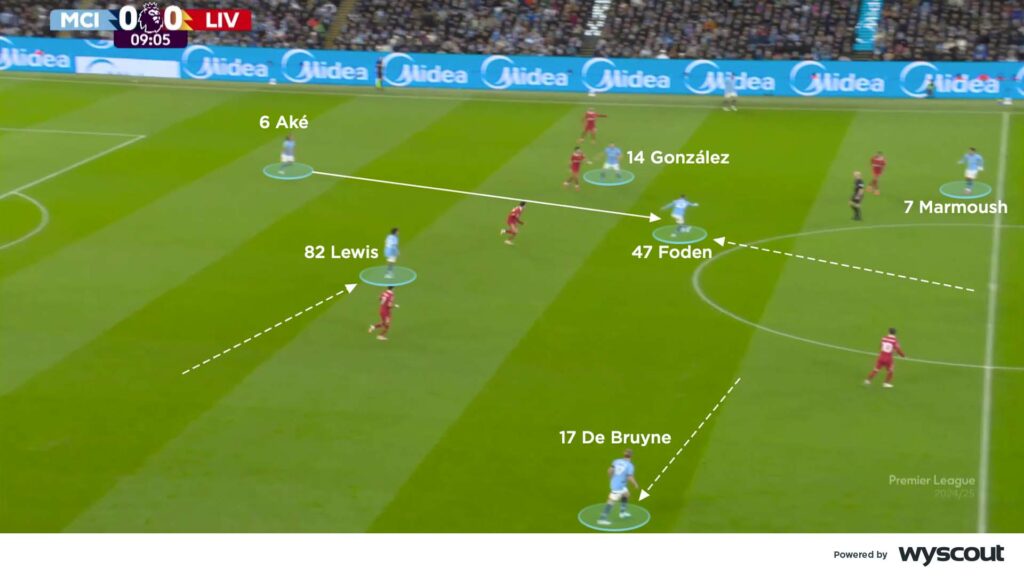
In response, Virgil van Dijk occasionally stepped into midfield, from where he could jump on any straight passes into Foden. Although this created a significant gap in Liverpool’s back line, City rarely exploited it. Instead, they often built by going through their two centre-backs to the widening – and increasingly deep – De Bruyne (below), who attempted to bend balls back inside. However, Liverpool could then lock City towards the touchline and defend any balls from there.
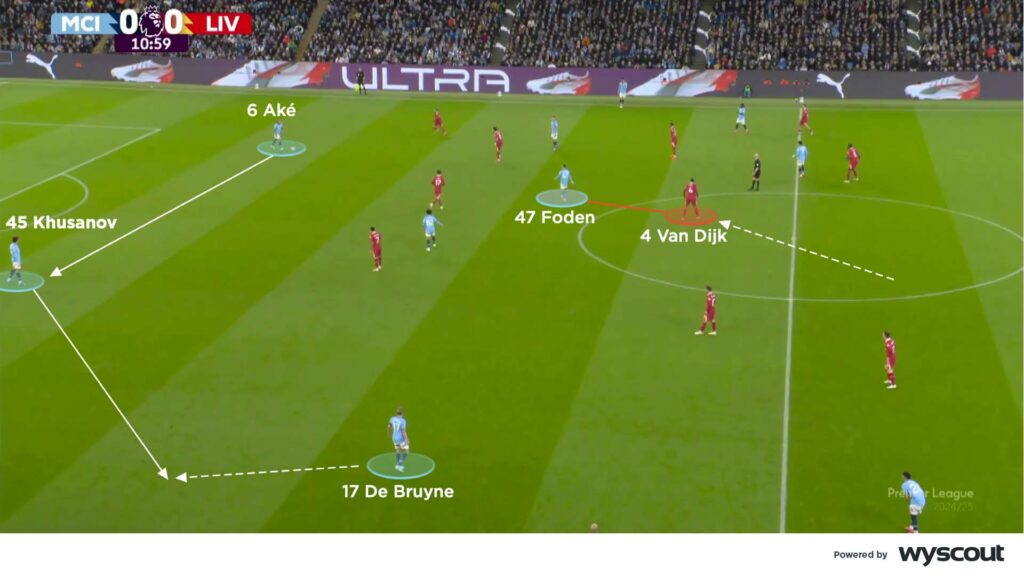
After conceding the opening goal, City rotated De Bruyne, Savinho and Foden, but Liverpool’s increasingly deep block was then able to better contain the opposition. Alexis Mac Allister covered any dropping threat from Foden, so that Van Dijk was able to stay in the back line. The player on the left of Liverpool’s front line – either Luis Díaz or Curtis Jones – dropped back and helped protect against City’s attempted rotations on this side. As such, the visitors allowed City’s least impactful player in possession, Abdukodir Khusanov, time on the ball (below). Although Jérémy Doku had the beating of Trent Alexander-Arnold on City’s left, they struggled to create clear-cut chances, despite steadily increasing their share of possession against Liverpool’s low block.
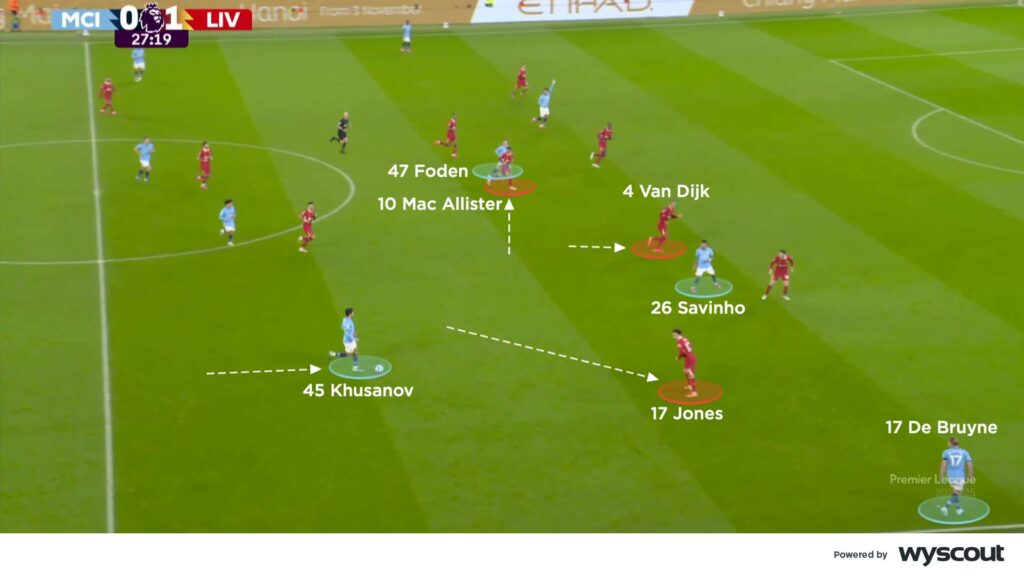
Liverpool utilised a 4-2-4 structure in possession, and like City they also deployed dropping central forwards – Jones and Szoboszlai moved towards the ball to initially overload City’s midfield trio. When City committed a centre-back to press into midfield, Liverpool faced a similar problem to the one they posed City. Slot’s side, however, had two players dropping centrally, meaning they could combine with one another when needed (below). They also had more purposeful passing, forward runs and overall attacking play from Salah and Díaz coming inside from wide – especially when exploiting City’s advancing centre-back.
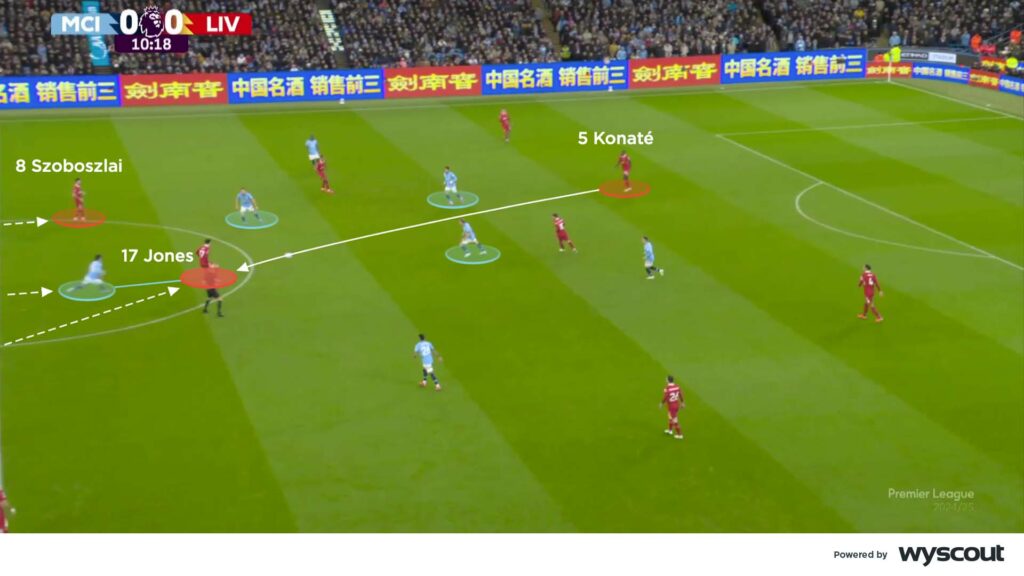
During Liverpool’s sustained spells of possession, left-back Andy Robertson advanced high. This allowed Díaz to attack inside, sometimes replacing Jones and Szoboszlai. Alexander-Arnold was much more reserved, rarely running forward. Instead, he demonstrated his forward-passing range, working the ball into the dropping Jones and Szoboszlai, or into Salah’s feet. Despite attacking less frequently and with fewer passes than City, Liverpool were more purposeful and clinical with the ball. Their second goal (below) showcased these qualities.
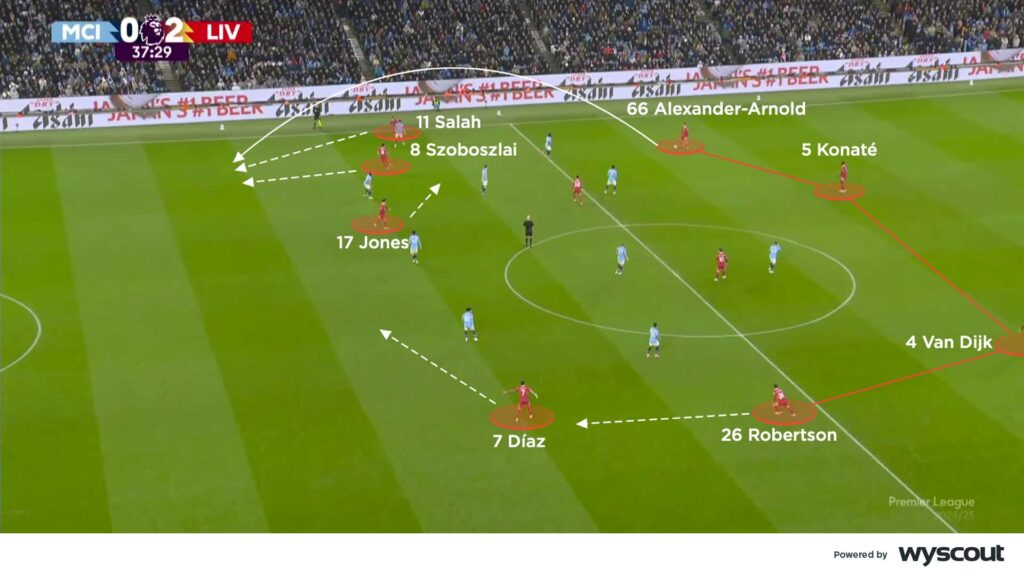
Liverpool’s block
Liverpool spent considerable periods of the second half in a low block. In doing so, they were outstanding at covering spaces, protecting their penalty area and limiting City’s attacking threats. Mac Allister often tracked De Bruyne’s forward runs, sometimes well into the back line. Ryan Gravenberch moved in the opposite direction to subdue Foden, when the City player dropped towards the ball. This in turn allowed Ibrahima Konaté or Van Dijk to protect against Marmoush’s runs and positioning, while also keeping a centre-back free for additional cover. The full-backs defended narrow, protecting the spaces either side of Gravenberch, supported by Salah and Díaz back-pressing (below).
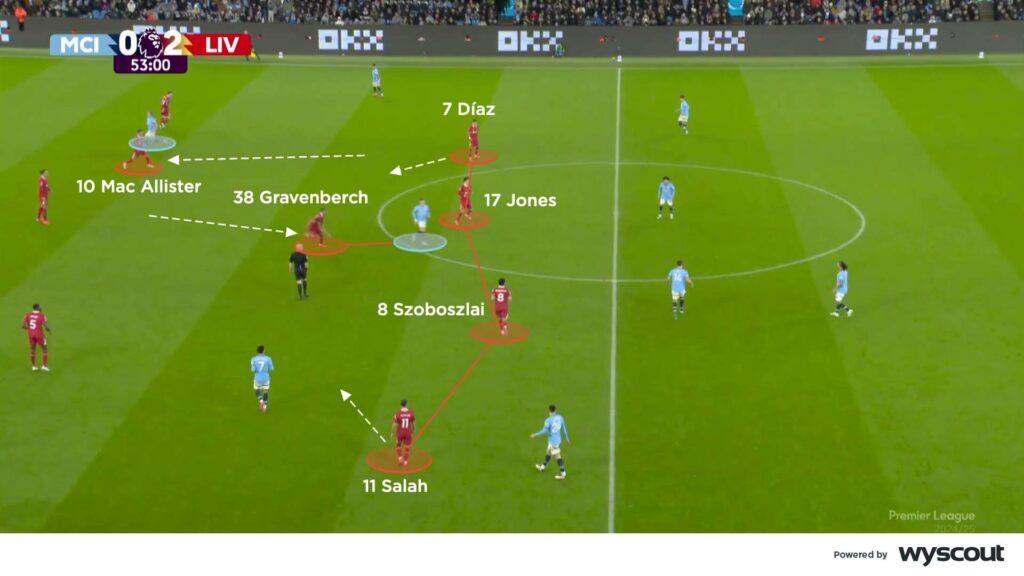
When Alexander-Arnold was faced with defending 1v1 against Doku, Gravenberch moved across to provide additional support. On this side, Salah and Szoboszlai also worked back to cover passes back inside (below), forcing City to play forward passes into congested central spaces.
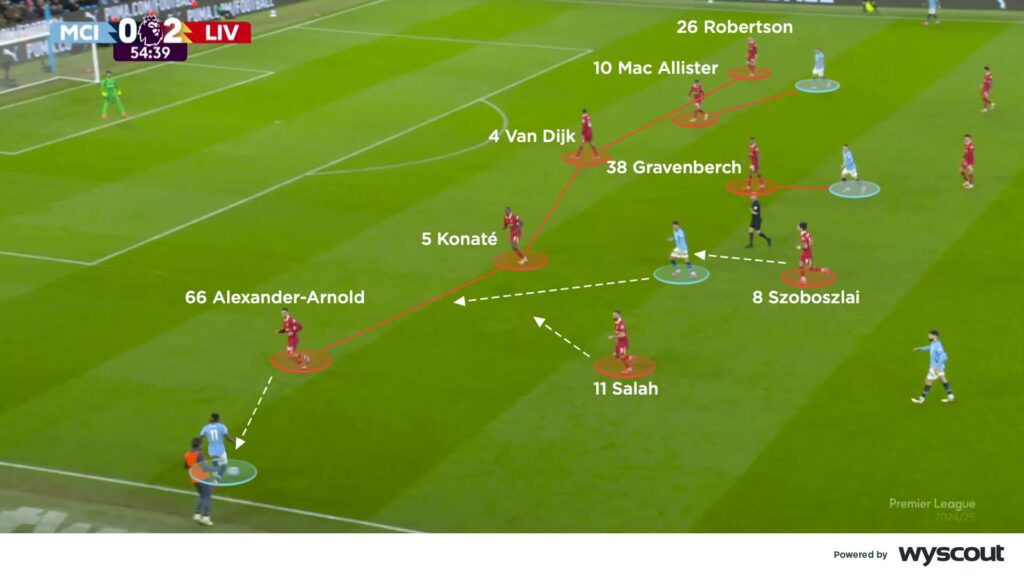
The result was that, although City had plenty of possession and played much of the second half in Liverpool’s half, the visitors always looked to be in control of the game. Their 2-0 victory, meanwhile, left them in firm control of the league championship’s destiny.
To learn more about football tactics and gain insights from coaches at the top of the game, visit CV Academy



